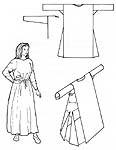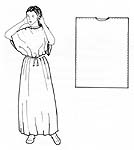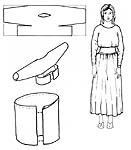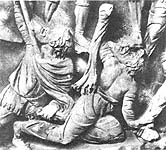 |
||||
|
Lesson #3: Page 3
The main types seem to be a full length 'chemise' of fine wool or linen (perhaps pleated like later Scandinavian examples). It was probably of simple cut, similar to a man's tunic but longer, reaching to somewhere between the knee and ankle, perhaps with the addition of gores to give more fullness to the skirt, or perhaps slits left open at the sides. These garments may have been sleeveless (perhaps similar to some late Roman and Frankish examples) or could have sleeves. The sleeves could be short (elbow length) or wrist length. This long sleeved style seems to be most often represented in Anglian areas, where wrist clasps were used to fasten the sleeves (this is a custom which seems to be almost exclusive to Anglian women), although a version without the wrist clasps may well have been worn in other areas. Wrist clasps often preserve the remains tablet woven (or occasionally soft leather) cuff bands. Some continental pictorial sources suggest thes sleeves could be almost skin tight. The short-sleeved version may be more typical of the Saxon woman, although it may have been worn under (or over), and in addition to, the bodice mentioned below. In Scandinavia a garment known as an oplod was worn as an undergarment until quite recently and seems to be a descendant of the short tops found in bronze age burials. It is in the form of a short bodice with long, tight sleeves, and made of linen. It may be a garment like this was worn under the peplos by Anglian women, and it was this garment that the wrist clasps were attached to. In very cold weather this type of garment could be worn with a short sleeved or sleeveless underdress of wool or linen, or perhaps with a petticoat. There is some continental pictorial evidence to suggest that a long 'petticoat' may have been worn under the peplos. This would probably have taken the form of a cylinder of cloth worn around the waist or hips, drawn tight with a drawstring around the top edge. These undergarments would usually have been of linen or fine wool. There is some evidence to suggest that on occasion a fine woollen underdress was warn over a linen one, although probably only one of them had long sleeves. There are several Old English words for underdresses but it is unclear which of them refer to women's garments. The words are cemes, ham, hemeðe, scyrte, serc and smoc. Making the Underdress
The underdress/chemise worn by women throughout the miiddle ages and on into the eighteenth century changed very little beyond the cut of the neckline and length of the hem. This is probably a good starting point. Most of these garments are made of two rectangles (or trapezoids) of linen, often with gores inserted into the side seams. The arms may be shaped, or (more likely) simple tubes with gussets set in at the arm-pits, the wrists gathered into cuff bands. The neck opening is usually curved, and may have sometimes have had a dawstring to tighten it (although be careful not to end up with the 'SCA wench' look), especially if the underdress were pleated. This arrangement would also make breast feeding more convenient! Click on image for larger version in new window Another good pattern is likely to be the simple dresses worn by some late Roman and Frankish women. These are very simple garments made from two rectangles (or perhaps even a tube) of cloth. The top of the tube is sewn closed apart from a neck opening and the tops of the side seams are left open for the arms (in the case of tubular fabrics slits must be made.) If these garments are made reasonably wide there is no need for gores for ease of movement, and the excess width at the soulders form elbow length 'sleeves'. Click on image for larger version in new window The bodice pattern may be derived from the Scandinavian oplod and earlier examples of bodice type tops. Click on image for larger version in new window Seperate Sleeves?
Click on image for larger version in new window Page
1 | Page 2 | Page 3 | Page
4 | Page 5 | Page
6 | Page 7 | Page
8
|
||||
| Costume
Classroom is a division of The
Costume Gallery, copyright 1997-2002.
Having problems with this webpage contact: questions@costumegallery.com |




